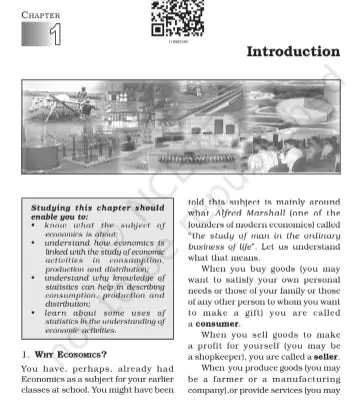‘NCERT Solutions for Class 11 Statistics Chapter 1 Statistics Introduction‘ PDF Quick download link is given at the bottom of this article. You can see the PDF demo, size of the PDF, page numbers, and direct download Free PDF of ‘Ncert Class 11 Statistics Chapter 1 Exercise Solution’ using the download button.
Statistics Introduction Book PDF Free Download

Chapter 1: Statistics Introduction
You have, perhaps, already had Economics as a subject for your earlier classes at school. You might have been told this subject is mainly around what Alfred Marshall (one of the founders of modern economics) called “the study of man in the ordinary business of life”.
Let us understand what that means. When you buy goods (you may want to satisfy your own personal needs or those of your family or those of any other person to whom you want to make a gift) you are called a consumer. When you sell goods to make a profit for yourself (you may be a shopkeeper), you are called a seller.
When you produce goods (you may be a farmer or a manufacturing company),or provide services (you may be a doctor, porter, taxi driver or transporter of goods) you are called a producer. When you are in a job, working for some other person, and you get paid for it (you may be employed by somebody who pays you wages or a salary), you are called an employee. When you employ somebody, giving them a wage, you are an employer.
In all these cases you will be called gainfully employed in an economic activity. Economic activities are ones that are undertaken for a monetary gain. This is what economists mean by ordinary business of life We cannot get something for nothing If you ever heard the story of Aladdin and his Magic Lamp, you would agree that Aladdin was a lucky guy.
Whenever and whatever he wanted, he just had to rub his magic lamp and a genie appeared to fulfill his wish. When he wanted a palace to live in, the genie instantly made one for him. When he wanted expensive gifts to bring to the king when asking for his daughter’s hand, he got them at the bat of an eyelid. In real life we cannot be as lucky as Aladdin.
Though, like him we have unlimited wants, we do not have a magic lamp. Take, for example, the pocket money that you get to spend. If you had more of it then you could have purchased almost all the things you wanted. But since your pocket money is limited, you have to choose only those things that you want the most.
This is a basic teaching of Economics. Scarcity is the root of all economic problems. Had there been no scarcity, there would have been no economic problem. And you would not have studied Economics either. In our daily life, we face various forms of scarcity. The long queues at railway booking counters, crowded buses and trains, shortage of essential commodities, the rush to get a ticket to watch a new film, etc., are all manifestations of scarcity.
We face scarcity because the things that satisfy our wants are limited in availability. Can you think of some more instances of scarcity? The resources which the producers have are limited and also have alternative uses. Take the case of food that you eat every day. It satisfies your want of nourishment. Farmers employed in agriculture raise crops that produce your food.
At any point of time, the resources in agriculture like land, labour, water, fertiliser, etc., are given. All these resources have alternative uses. The same resources can be used in the production of nonfood crops such as rubber, cotton, jute etc. Thus, alternative uses of resources give rise to the problem of choice between different commodities that can be produced by those resources.
| Author | NCERT |
| Language | English |
| No. of Pages | 8 |
| PDF Size | 1.7 MB |
| Category | Statistics |
| Source/Credits | ncert.nic.in |
NCERT Solutions Class 11 Statistics Chapter 1 Statistics Introduction
Q1: Mark the following statements as true or false. (i) Statistics can only deal with quantitative data. (ii) Statistics solve economic problems. (iii) Statistics is of no use to Economics without data.
Answer :
(i) Statistics can only deal with quantitative data. False Statistics deals with both quantitative data as well as with qualitative data. Statistics not only reveals quantitative information but also reflects the qualitative aspect of data like better, worse off, highly skilled, etc. Although, the qualitative aspects can neither be easily measured nor can be expressed in quantitative terms, but statistics describes the attributes of these variables.
(ii) Statistics solves economic problem. True Statistics acts as a tool in the hands of economists that enables them to understand and evaluate an economic problem. The causes of a problem are identified through statistical tools and methods and policies and rectification measures are formulated accordingly. Oil Statistics is of no use to economics without data. True Data enable economists to present economic facts in a precise and concise form.
Data itself is self explanatory. For example, if the per capita monthly income in India has increased from Rs 300 to Rs 600 during 1974 to 1984, then just by looking at the figures an economist would not only understand the quantitative increase in the per capita income but also can assess the implicit qualitative aspects associated with this increase like higher standard of living, low level of poverty, higher level of savings, etc.
Q2: Make a list of activities that constitute the ordinary business of life. Are these economic activities?
Answer :
The following are the activities that constitute the ordinary business of life: 1. Buying of goods and services. 2. Rendering services to a company by employees and workers. 3. Selling of goods and services. 4. Production process carded out by a firm. Yes, the above mentioned activities are regarded as economic activities. This is because, these activities involve the use of scarce resources to carry out production, consumption, saving, investment, etc. These activities involve the exchange of money to earn livelihood.
Q3: ‘The Govemment and policy makers use statistical data to formulate suitable policies of economic development’. Illustrate with two examples.
Answer :
The statistical data is of prime importance for the government and the policy makers. The statistical data not only help them to analyse and evaluate the outcomes of the past policies but also assist them to take corrective measures and to formulate new policies accordingly. Further. the statistical data also help the government to ascertain various ne.s and priorities for the pursuit of the common goal of econornic development.
For example, if Indian Government aims at encouraging the production level, then it formulates its economic policy based on the average production level of the past three years. Another example could be the preparation of government budget. The previous data of government expenditures and govemment revenues are taken into consideration for estimating the allocation of funds among various projects.
NCERT Class 11 Statistics Textbook Chapter 1 With Answer PDF Free Download
